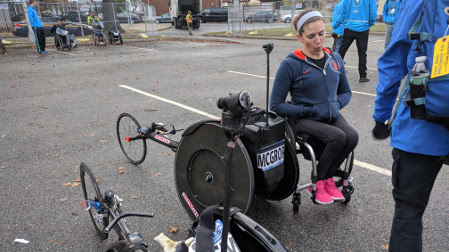NEW YORK—CP Communications, an Elmsford, N.Y. -based production services and digital media technology rental company, relied on a combination of microwave and bonded cellular technology to deliver live shots from the women’s wheelchair race during the Nov. 5 New York City Marathon.

A 5.8-ounce package from Inertia Unlimited including camera and microwave transmitter was affixed to the wheelchair of the New York City Marathon Women’s Wheelchair race contestant. Shots from the setup were microwaved to an accompanying scooter equipped with a receiver and AWIWEST bonded cellular transmitter for integration into race coverage. Photo: Jim Malone.
"The only way to get live pictures from the course during a marathon is to use wireless technology. From there, bonded cellular is a good option for ensuring video gets where it needs to go, even in a dynamic, uncontrollable environment with millions of people taxing the network," said Jim Malone, director of technology for CP Communications.
CP Communications’ strategy involved mounting a 5.8-ounce package from Inertia Unlimited that included a camera, battery and microwave transmitter, onto a wheelchair of one of the contestants. The camera was stationed over the athlete’s right shoulder to capture the perspective of a race participant.
Shots from the camera were transmitted via microwave to a scooter CP Communications outfitted with a microwave receiver and an Aviwest DMNG Pro180-RA bonded cellular system. The scooter accompanied the contestant throughout the race.
The Aviwest bonded system, which is distributed in the U.S. by master distributor VidOvation, streamed incoming video from the microwave receiver to the internet.
An Aviwest DMNG StreamHub studio receiver inside a production truck accepted the contribution from the scooter, while built-in Aviwest SafeStreams technology applied special stream-grooming techniques to improve link quality and reliability, according to a VidOvation press release. The retrieved streaming footage was then passed onto a video production switcher for integration into the production of the race.
The professional video industry's #1 source for news, trends and product and tech information. Sign up below.
While CP Communications relied on the Aviwest DMNG Pro180-RA as a backup to its microwave setup to cover the men’s and women’s marathon, the bonded cellular solution served as the exclusive source of video from the scooter during the women’s wheelchair race coverage.
Overall, CP Communications relied on more than 50 technicians and nine vehicles at the marathon. Production teams tracked alongside selected runners and wheelchair participants to capture live video from the course to relay footage to viewers watching ABC, ESPN and other Disney properties, the release said.
Phil Kurz is a contributing editor to TV Tech. He has written about TV and video technology for more than 30 years and served as editor of three leading industry magazines. He earned a Bachelor of Journalism and a Master’s Degree in Journalism from the University of Missouri-Columbia School of Journalism.

